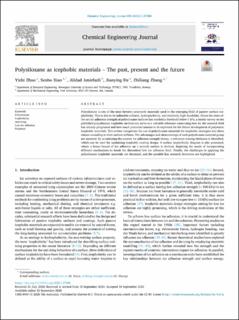| dc.contributor.author | Zhuo, Yizhi | |
| dc.contributor.author | Xiao, Senbo | |
| dc.contributor.author | Amirfazli, Alidad | |
| dc.contributor.author | He, Jianying | |
| dc.contributor.author | Zhang, Zhiliang | |
| dc.date.accessioned | 2020-10-28T15:14:21Z | |
| dc.date.available | 2020-10-28T15:14:21Z | |
| dc.date.created | 2020-09-22T15:53:31Z | |
| dc.date.issued | 2020 | |
| dc.identifier.issn | 1385-8947 | |
| dc.identifier.uri | https://hdl.handle.net/11250/2685550 | |
| dc.description.abstract | Polysiloxane is one of the most favorite polymeric materials used in the emerging field of passive surface icephobicity; This is due to its tailorable softness, hydrophobicity, and relatively high durability. Given the state-of-the-art ice adhesion strength of polysiloxane surfaces has reached a threshold below 1 kPa, a timely survey on the published polysiloxane icephobic surfaces can serve as a valuable reference concerning how far the research field has already progressed and how much potential remains to be exploited for the future development of polymeric icephobic materials. This review categorizes the use of polysiloxane materials for icephobic strategies into three classes according to their surface stiffness. The advantages and shortcomings of each polysiloxane material group are assessed. By scrutinizing the current ice adhesion strength theory, a reference coating thickness is identified, which can be used for optimizing icephobic coating design. A surface icephobicity diagram is also presented, where a lower bound of ice adhesion on a smooth surface is derived, depicting the needs of incorporating different mechanisms to break the theoretical low ice adhesion limit. Finally, the challenges in applying the polysiloxane icephobic materials are discussed, and the possible key research directions are highlighted. | en_US |
| dc.language.iso | eng | en_US |
| dc.publisher | Elsevier | en_US |
| dc.rights | Navngivelse 4.0 Internasjonal | * |
| dc.rights.uri | http://creativecommons.org/licenses/by/4.0/deed.no | * |
| dc.title | Polysiloxane as icephobic materials – the past, present and the future | en_US |
| dc.type | Journal article | en_US |
| dc.type | Peer reviewed | en_US |
| dc.description.version | publishedVersion | en_US |
| dc.source.journal | Chemical Engineering Journal | en_US |
| dc.identifier.doi | 10.1016/j.cej.2020.127088 | |
| dc.identifier.cristin | 1832223 | |
| dc.relation.project | Norges forskningsråd: 250990 | en_US |
| dc.relation.project | Norges forskningsråd: 255507 | en_US |
| dc.description.localcode | 2020 The Author(s). Published by Elsevier B.V. This is an open access article under the CC BY license (http://creativecommons.org/licenses/by/4.0/) | en_US |
| cristin.ispublished | false | |
| cristin.fulltext | postprint | |
| cristin.qualitycode | 2 | |

